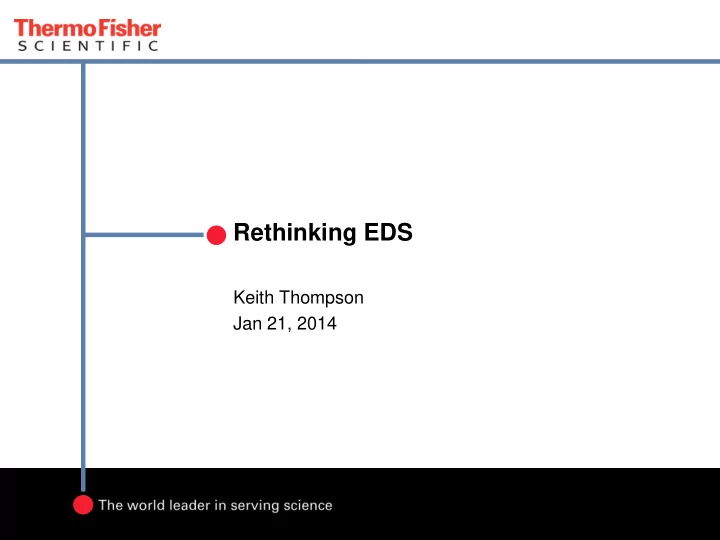

Rethinking EDS Keith Thompson Jan 21, 2014
Outline • Background on EDS detector technology • Discussion of modern EDS detectors • Finding the right detector for your application Proprietary & Confidential 2
EDS & WDS: 1950s • The first “EDS-styled” analytical technique was actually WDS • Based on Bragg diffraction • First EPMA built in 1949 by Raymond Castaing • The spectrometer looked at 1 element at a time • The spectrometer was manually adjusted Proprietary & Confidential 3
1960s: EDS becomes mainstream with Si(Li) detectors Whole spectrum at once type of analysis Computing power to run the system and process the data Acceptance of EDS in the SEM community Proprietary & Confidential 4
Drawbacks to the first Si(Li) EDS detectors • X-ray loss in Be window • Window required to protect Si(Li) module • No spectrum < 1 keV with Be windows • Poor energy resolution and count rates • ~ 145 eV at < 2,000 X-ray stores per second • ~ 200 eV at up to 20,000 X-ray stores per second • Inherent limitations to active area • The constant requirement for Liquid Nitrogen! Despite these drawbacks, LN-cooled detectors would dominate EDS for 40 + years Proprietary & Confidential 5
1988: First no-LN cooled detector • Mechanical cooling with Peltier devices were used to replace Liquid Nitrogen cooled detectors. • No LN ever again! Proprietary & Confidential 6
SuperDry at high count rates: 54,000 cps • Resolution at count rate remained a challenge • Window transmission challenges remained • Potential reliability concerns with mechanical vibration (shaking of the electron image) and water recirculation (water leaks) Proprietary & Confidential 7
Modern EDS for the new Millennium • Novel light element windows allowed transmission to Be • PC-based acquisition and data storage • Element mapping evolves into Spectral Imaging • SDD – based EDS detectors commercially available Proprietary & Confidential 8
The SDD revolution SDD vs. LN circa 2002 Same sensitivity in one third the time! (Spectra taken at same beam current) Proprietary & Confidential 9
SDD Benefit versus Si(Li) at High Throughput SDD Spectrum Si(Li) Spectrum • At high count rates, conventional Si(Li) experiences significant peak shift and loss of sensitivity for light elements • The UltraDry SDD maintains resolution at high count rates Proprietary & Confidential 10
2 nd generation SDD: Improved Light element Proprietary & Confidential 11
3 rd Generation Silicon Drift Detector Si(Li) Larger detectors for faster throughput: 10, 30, 60, 100 Improved energy resolution Improved light element Proprietary & Confidential 12
Outstanding low energy resolution Clear peak separation Excellent peak – background Proprietary & Confidential 13
SDD Gen 3 vs. SDD Gen 2 60 mm 2 10 mm 2 10 mm 2 Proprietary & Confidential 14
Large Area detectors: What does it mean to me? 256 pixel x 192 pixel resolution 20 second acquisition CuFeS Epoxy Quartz NiFeS FeS 10 mm 2 detector 100 mm 2 detector 15 counts/pixel 120 counts/pixel 1 Larger area detectors collect more X-rays under identical circumstances 1. Collection rate saturated at 300,000 stored counts per second Proprietary & Confidential 15
Steady resolution with count rate 60 mm2 SDD detector at: 10,000 cps 100,000 cps 300,000 cps Proprietary & Confidential 16
Light Element Detection – Li mapping Proprietary & Confidential 17
A retrospective • Before 2000 • LN dominated • Slow count rates • Poor energy resolution • Be windows….. Poor light element • No spectral imaging…. Pick your element and hit “Go” • Modern detectors • Large area detectors • Very high count rates • Outstanding energy resolution across the spectrum • Light element detection to Li • How does my detector stack up against my application? Proprietary & Confidential 18
TEM & nanoscale Fast mapping Large mosaics Complex mapping at low energy Active area … SIZE Many elements over a large area Point & shoot applications Failure analysis Light element analysis Quality control … Lithium detection w/ EBSD Defect review … B in glass Careful Quant of Microprobe trace elements Spectral resolution Proprietary & Confidential 19
Introducing: ThermoScientific UltraDry Compact EDS system
Thermo Scientific UltraDry Compact EDS system • What it is: • A stream-lined, smaller and cost-effective EDS detector • Fixed length, standardized design that bolts easily to the WDS port • Who needs it? • Those who want to perform high-quality, chemical analysis in an electron microscope but don’t have the budget to pay for a high-end spectroscopic instrument. Proprietary & Confidential 21
UltraDry Compact EDS TEM & nanoscale Fast mapping Large mosaics Complex mapping at low energy Active area … SIZE Many elements over a large area Point & shoot applications Failure analysis Light element analysis Quality control … Lithium detection w/ EBSD … B in glass Defect review Careful Quant of Microprobe trace elements Spectral resolution Proprietary & Confidential 22
More than adequate Spectral Performance The overall spectral performance we expected from 2 nd generation SDDs …. We still get that and more. Proprietary & Confidential 23
Ideal for Point & Shoot analysis Proprietary & Confidential 24
Element mapping when you need it Proprietary & Confidential 25
Spectral Imaging: example extracted linescan Proprietary & Confidential 26
Spectral Imaging: example area extraction Proprietary & Confidential 27
The ThermoScientific Compact EDS System Everything you’ve come to expect from EDS detector technology Proprietary & Confidential 28
Recommend
More recommend